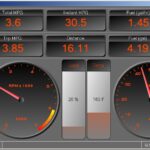Automotive Oscilloscope Diagnostics are crucial for today’s vehicles. As automotive technology becomes increasingly complex, relying solely on traditional diagnostic tools like multimeters or scan tools is no longer sufficient. Oscilloscopes provide a deeper dive into the intricate electrical signals within a vehicle, enabling accurate identification of issues and efficient repairs. This guide explores the applications, benefits, and practical use of oscilloscopes in modern automotive diagnostics.
Understanding Automotive Oscilloscope Diagnostics
An oscilloscope allows technicians and engineers to visualize electrical signals as waveforms, revealing anomalies that other tools might miss. Unlike multimeters that provide basic voltage or current readings, oscilloscopes display the dynamic behavior of these signals over time. This detailed view is essential for diagnosing intermittent faults, complex interactions between components, and issues related to signal timing and integrity.
Key Applications in Automotive Diagnostics
Oscilloscope diagnostics find applications across various vehicle systems:
Vehicle Electronics Integration
Modern vehicles rely heavily on electronics for power management, control systems, and infotainment. Oscilloscopes are vital for testing inverters, motors, and other components within these systems, ensuring their reliable operation. They can analyze voltage and current waveforms, detect switching anomalies, and help pinpoint issues in power electronics circuits.
In-Vehicle Networking Diagnostics
Today’s cars utilize intricate communication networks like CAN, LIN, and FlexRay. Oscilloscopes are invaluable for analyzing the signals on these networks, ensuring proper communication between different modules. They can decode messages, identify corrupted data, and diagnose network connectivity problems.
Timing Analysis
Precise timing is crucial for many automotive systems, especially those related to engine control and safety features. Oscilloscopes provide accurate timing measurements, helping diagnose issues related to sensor synchronization, signal delays, and communication latency. This is particularly important for high-speed data buses and real-time control systems.
Practical Use of an Automotive Oscilloscope
Service-Level/In-Vehicle Diagnostics
Connecting the oscilloscope to the vehicle’s diagnostic port using appropriate probes is the first step. Setting the voltage range and timebase settings correctly is crucial for capturing the desired signal. Technicians then interpret the displayed waveforms to identify abnormalities, referencing known good patterns or specifications.
Device-Level Diagnostics
At the component level, oscilloscopes are used to test individual sensors, actuators, and electronic control units (ECUs). By analyzing the input and output signals, technicians can pinpoint faulty components or diagnose internal circuit problems. Waveform analysis reveals insights into component behavior and helps isolate the root cause of malfunctions.
Benefits of Automotive Oscilloscope Diagnostics
- Precise Fault Detection: Identify even subtle signal anomalies.
- Efficient Troubleshooting: Quickly pinpoint the root cause of issues.
- Versatility: Diagnose a wide range of electrical and electronic systems.
- In-Depth Analysis: Gain comprehensive insights into signal behavior and system performance.
Conclusion
Automotive oscilloscope diagnostics are essential for effectively troubleshooting and repairing today’s complex vehicles. They empower technicians and engineers with the ability to analyze signals in detail, leading to accurate diagnoses and faster repairs. As vehicle technology continues to advance, the role of automotive oscilloscopes will only become more critical in ensuring vehicle reliability and performance.
